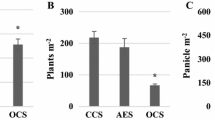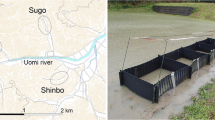Abstract
Organic farming was developed to reduce agriculture’s negative impacts on the environment and enhance biodiversity for sustainable productivity in agricultural ecosystems, but the long-term effectiveness of its application in Japanese rice paddies is unclear. We sought to understand how long-term organic farming affects the abundance of animals in both the rice growth and fallow seasons, and how soil properties change. We investigated the abundance of fishes, frogs, beetles, and shellfish in the floodwater in summer, and the abundance of earthworms (mainly Enchytraeidae), arthropods (spiders and springtails), and soil properties in aerobic soils in autumn. We examined fields which had been farmed organically for 10 and 18 years in Tochigi, Japan. Fields farmed with conventional management, located close to the selected organic fields, were used as a control. All selected fields were located in a valley, which is the typical landscape of a traditional Japanese farming village, called a yatsuda in Japanese. The results showed an increase in soil organic carbon, total nitrogen, and available phosphorus in plowed soils that had been converted from conventional to organic farming both 10 and 18 years earlier. However, the abundance of various animals were not affected significantly by long-term organic rice farming, other than arthropods in the aerobic soils that had been farmed organically for 18 years. The quantity of most animals in floodwater and fallow season soil was unaffected by long-term organic rice farming in the yatsuda paddy fields, probably due to the circumstances and similar irrigation systems for both conventional and organic rice farming, as well as lighter doses of agrochemical application for conventional rice cultivation.



Similar content being viewed by others
References
Brown, M. E., & Funk, C. C. (2008). Food security under climate change. Science, 319, 580–581.
Cheng, W., Okamoto, Y., Takei, M., Tawaraya, K., & Yasuda, H. (2015a). Combined use of Azolla and loach suppressed weed Monochoria vaginalis and increased rice yield without agrochemicals. Organic Agriculture, 5, 1–10.
Cheng, W., Takei, M., Sato, C., Kautsar, K., Sasaki, Y., Sato, S., Tawaraya, K., & Yasuda, H. (2015b). Combined use of Azolla and loach suppressed paddy weeds and increased organic rice yield: second season results. Journal of Wetlands Environmental Management, 3, 1–13.
Cheng, W., Padre, A. T., Shiono, H., Sato, C., Nguyen-Sy, T., Tawaraya, K., & Kumagai, K. (2017). Changes in the pH, EC, available P, SOC and TN stocks in a single rice paddy after long-term application of inorganic fertilizers and organic matters in a cold temperate region of Japan. Journal of Soils and Sediments, 17, 1834–1842.
Cheng, W., Kimani, S. M., Kanno, T., Tang, S., Oo, A. Z., Tawaraya, K., Sudo, S., Sasaki, Y., & Yoshida, N. (2018). Forage rice varieties Fukuhibiki and Tachisuzuka emit larger CH4 than edible rice Haenuki. Soil Science and Plant Nutrition, 64, 77–83.
Choosai, C., Jouquet, P., Hanboonsong, Y., & Hartmann, C. (2010). Effects of earthworms on soil properties and rice production in the rainfed paddy fields of Northeast Thailand. Applied Soil Ecology, 45, 298–303.
Dewi, V. K., Sato, S., & Yasuda, H. (2017). Effects of a mud snail Cipangopaludina chinensis laeta (Architaenioglossa: Viviparidae) on the abundance of terrestrial arthropods through rice plant development in a paddy field. Applied Entomology and Zoology, 52, 97–106.
FAO (2018) AOSTAT database. http://faostat.fao.org/. (accessed December, 2018).
Feber, R. E., Bell, J., Johnson, P. J., Firbank, L. G., & MacDonald, D. W. (1998). The effects of organic farming on surface-active Spider (Araneae) assemblages in wheat in southern England, UK. The Journal of Arachnology, 26, 190–202.
Folgarait, P. J., Thomas, F., Desjardins, T., Grimaldi, M., Tayasu, I., Curmi, P., & Lavelle, P. M. (2003). Soil properties and the macrofauna community in abandoned irrigated rice fields of northeastern Argentina. Biology and Fertility of Soils, 38, 349–357.
Gattinger, A., Muller, A., Haeni, M., Skinner, C., Fliessbach, A., Buchmann, N., Mäder, P., Stolze, M., Smith, P., Scialabba, N. E., & Niggli, U. (2012). Enhanced top soil carbon stocks under organic farming. Proceedings of the National Academy of Sciences of USA, 109, 18226–18231.
Hoang, D. T. T., Bauke, S. L., Kuzyakov, Y., & Pausch, J. (2017). Rolling in the deep: priming effects in earthworm biopores in topsoil and subsoil. Soil Biology and Biochemistry, 114, 59–71.
Jiang, R., Wang, C., Hatano, R., Kuramochi, K., Hayakawa, A., & Woli, K. P. (2015). Factors controlling the long-term temporal and spatial patterns of nitrate-nitrogen export in a dairy farming watershed. Environmental Monitoring and Assessment, 187, 206. https://doi.org/10.1007/s10661-015-4394-9.
JSSSPN (Japanese Society of Soil Science and Plant Nutrition). (1986). Soil normal analysis methods. Tokyo: Hakuyusha Press (in Japanese).
Kadoya, T., & Washitani, I. (2011). The Satoyama Index: a biodiversity indicator for agricultural landscapes. Agriculture, Ecosystems and Environment, 140, 20–26.
Katayama, N., Baba, Y. G., Kusumoto, Y., & Tanaka, K. (2015). A review of post-war changes in rice farming and biodiversity in Japan. Agricultural Systems, 132, 73–84.
Katoh, K., Sakai, S., & Yahahashi, T. (2009). Factors maintaining species diversity in satoyama, a traditional agricultural landscape of Japan. Biological Conservation, 142, 1930–1936.
Kurniawan, A. H., Sato, S., & Yasuda, H. (2018). Effects of ambient temperature and the mud snail Cipangopaludina chinensis laeta (Architaenioglossa: Viviparidae) on performance of rice plants. Applied Entomology and Zoology, 53, 137–141.
Lal, R. (2004). Soil carbon sequestration impacts on global climate change and food security. Science, 304, 1623–1627.
Lopes, A. R., Faria, C., Prieto-Fernández, A., Trasar-Cepeda, C., Manaia, C. M., & Nunes, O. C. (2011). Comparative study of the microbial diversity of bulk paddy soil of 2 rice fields subjected to organic and conventional farming. Soil Biology and Biochemistry, 43, 115–125.
Luo, L., Itoh, S., Zhang, Q., Yang, S., Zhang, Q., & Yang, Z. (2011). Leaching behavior of nitrogen in a long-term experiment on rice under different N management systems. Environmental Monitoring and Assessment, 177, 141–150.
MAFF (2017) About promoting forage rice (Shiryoyoumei no Suishin ni Tsuite). Ministry of Agriculture, Forestry and Fisheries (MAFF), February 2017 (in Japanese). http://www.maff.go.jp/j/seisan/kokumotu/pdf/siryomai_meguji_2902.pdf.Ryohei.
Meader, P., Fliessbach, A., Dubois, D., Gunst, L., Fried, P., & Niggli, U. (2002). Soil fertility and biodiversity in organic farming. Science, 296, 1694–1697.
Nakajima, M., Cheng, W., Tang, S., Hori, Y., Yaginuma, E., Hattori, S., Hanayama, S., Tawaraya, K., & Xu, X. (2016). Modeling aerobic decomposition of rice straw during off-rice season in an Andisol paddy soil in a cold temperate region, Japan: effects of soil temperature and moisture. Soil Science and Plant Nutrition, 62, 90–98.
Sakuraoka, R., Toriyama, K., Kobayashi, K., Yamada, S., Kamioka, H., & Mori, S. (2018). Incorporation of fallow weed increases phosphorus availability in a farmer’s organic rice fields on allophanic Andosol. Soil Science and Plant Nutrition, 64, 300–305.
Schoenly, K. G., Cohen, J. E., Heong, K. L., Litsinger, J. A., Barrion, A. T., & Arida, G. S. (2010). Fallowing did not disrupt invertebrate fauna in Philippine low-pesticide irrigated rice fields. Journal of Applied Ecology, 47, 593–602.
Scialabba, N. E. H., & Muller-Lindenlauf, M. (2010). Organic agriculture and climate change. Renewable Agriculture and Food Systems, 25, 158–169.
Seufert, V., Ramankutty, N., & Foley, J. (2012). Comparing the yields of organic and conventional agriculture. Nature, 485, 229–232.
Shiga, H., Ouyama, N., Maeda, K., & Suzuki, M. (1985) An evaluation of different organic materials based on their decomposition patterns in Paddy soils. Bulletin of the National Agriculture Research Center, No. 5 pp 1–19 (in Japanese with English summary).
Smil, V., & Kobayashi, K. (2012). Japan’s dietary transition and its impacts. Cambridge: The MIT Press.
Takada, M. B., Yoshioka, A., Takagi, S., Iwabuchi, S., & Washitani, I. (2012). Multiple spatial scale factors affecting mirid bug abundance and damage level in organic rice. Biological Control, 60, 169–174.
Takeda, M., Nakamoto, T., Miyazawa, K., Murayama, T., & Okada, H. (2009). Phosphorus availability and soil biological activity in an Andosol under compost application and winter cover cropping. Applied Soil Ecology, 42, 86–95.
Tanaka, A., Toriyama, K., & Kobayashi, K. (2012). Nitrogen supply via internal nutrient cycling of residues and weeds in lowland rice farming. Field Crops Research, 137, 251–260.
Tang, S., Cheng, W., Hu, R., Guigue, J., Kimani, S. M., Tawaraya, K., & Xu, X. (2016). Simulating the effects of soil temperature and moisture in the off-rice season on rice straw decomposition and subsequent CH4 production during the growth season in a paddy soil. Biology and Fertility of Soils, 52, 739–748.
Tilman, D., Cassman, K. G., Matson, P. A., Naylor, R., & Polasky, S. (2002). Agricultural sustainability and intensive production practices. Nature, 418, 671–677.
Trisnawati, D. W., Tsukamoto, T., & Yasuda, H. (2015). Indirect effects of nutrients in organic and conventional paddy field soils on the rice grasshopper, Oxya japonica (Orthoptera: Acrididae), mediated by rice plant nutrients. Applied Entomology and Zoology, 50, 99–107.
Tsutsui, M. H., Kobayashi, K., & Miyashita, T. (2018). Temporal trends in arthropod abundances after the transition to organic farming in paddy fields. PLoS ONE, 13, e0190946. https://doi.org/10.1371/journal.pone.0190946.
Tuomisto, H. L., Hodge, I. D., Riordan, P., & Macdonald, D. W. (2012). Does organic farming reduce environmental impacts? A meta-analysis of European research. Journal of Environmental Management, 112, 309–320.
Waksman, S. A., & Gerretsen, F. C. (1931). Influence of temperature and moisture upon the nature and extent of decomposition of plant residues by microorganisms. Ecology, 12, 33–60.
Watanabe, K., Koji, S., Hidaka, K., & Nakamura, K. (2013). Abundance, diversity, and seasonal population dynamics of aquatic Coleoptera and Heteroptera in rice fields: Effects of direct seeding management. Environmental Entomology, 42, 841–850.
Acknowledgments
We thank Mr. Hiroyuki Tateno for permitting us to conduct the field survey in his paddy fields and for providing information regarding his agronomic practices. We also thank the members in Soil Science Lab and Animal Ecology Lab, Faculty of Agriculture, Yamagata University, for helping us with the field sampling and identification of animals.
Funding
This work was supported by JSPS Grant-in-Aid for Scientific Research Grant Number (B) 26310304.
Author information
Authors and Affiliations
Corresponding authors
Additional information
Publisher’s note
Springer Nature remains neutral with regard to jurisdictional claims in published maps and institutional affiliations.
This article is part of the Topical Collection on Managing Ecosystem Services and Biodiversity of Agricultural Systems
Supplementary Information
ESM 1
(PDF 524 kb)
Rights and permissions
About this article
Cite this article
Kurniawan, A.H., Sato, S., Cheng, W. et al. Animal abundance and soil properties affected by long-term organic farming in rice paddies in a typical Japanese yatsuda landscape. Environ Monit Assess 193 (Suppl 1), 273 (2021). https://doi.org/10.1007/s10661-020-08813-1
Received:
Accepted:
Published:
DOI: https://doi.org/10.1007/s10661-020-08813-1




